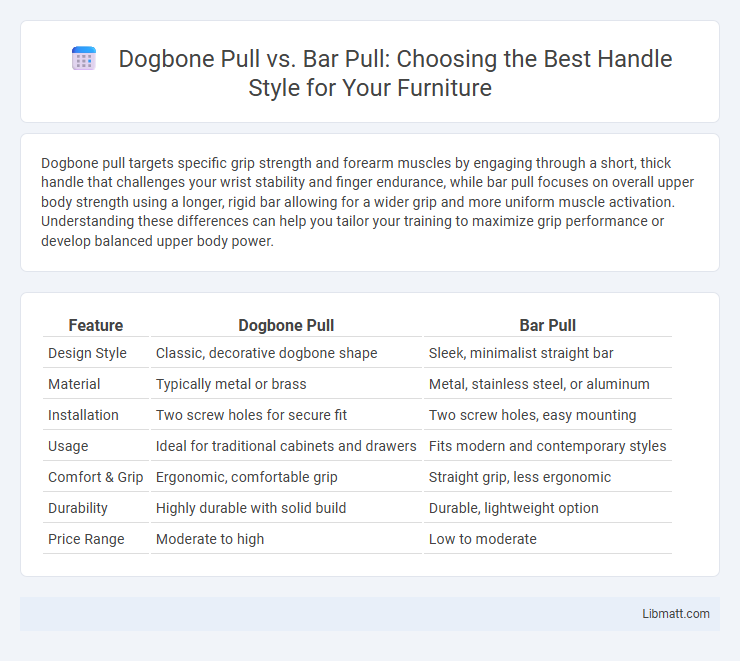Dogbone pull targets specific grip strength and forearm muscles by engaging through a short, thick handle that challenges your wrist stability and finger endurance, while bar pull focuses on overall upper body strength using a longer, rigid bar allowing for a wider grip and more uniform muscle activation. Understanding these differences can help you tailor your training to maximize grip performance or develop balanced upper body power.
Table of Comparison
| Feature | Dogbone Pull | Bar Pull |
|---|---|---|
| Design Style | Classic, decorative dogbone shape | Sleek, minimalist straight bar |
| Material | Typically metal or brass | Metal, stainless steel, or aluminum |
| Installation | Two screw holes for secure fit | Two screw holes, easy mounting |
| Usage | Ideal for traditional cabinets and drawers | Fits modern and contemporary styles |
| Comfort & Grip | Ergonomic, comfortable grip | Straight grip, less ergonomic |
| Durability | Highly durable with solid build | Durable, lightweight option |
| Price Range | Moderate to high | Low to moderate |
Introduction to Dogbone Pull vs Bar Pull
Dogbone pull and bar pull are resistance training exercises targeting the upper back and shoulders, with dogbone pulls emphasizing grip strength and wrist stability through unique handle design. Bar pulls utilize a straight or cambered bar to engage the lats, traps, and rhomboids with a more traditional pull motion. Both exercises improve pulling power but differ in grip mechanics and muscle activation patterns.
Understanding Dogbone Pull Tests
Dogbone pull tests use standardized, hourglass-shaped specimens to evaluate tensile strength and elongation, minimizing stress concentration for accurate material characterization. Bar pull tests often employ uniform cylindrical samples, which may not reflect true material behavior under stress due to uneven force distribution. Understanding that dogbone pull tests provide more precise and reliable data can enhance your material testing accuracy and product quality.
Overview of Bar Pull Tests
Bar pull tests measure the tensile strength and elongation of materials using a standardized metal bar, ensuring consistent and reliable results for material performance evaluation. These tests provide critical data on how materials behave under tension, which is essential for structural integrity assessments in engineering and manufacturing. Your choice between bar pull and dogbone pull tests depends on the specific application and the material geometry involved.
Key Differences Between Dogbone and Bar Pull
Dogbone pull uses a shorter, curved metal link designed for flexibility and ease of installation, while bar pull features a straight, rod-like handle offering a sleek, linear look. Dogbone pulls typically provide a more ergonomic grip and are suited for cabinets with smaller surfaces, whereas bar pulls are favored for modern designs and larger drawers due to their extended reach. Material choices for both vary from stainless steel to brass, but the dogbone often emphasizes vintage or rustic aesthetics in contrast to the minimalist style of bar pulls.
Applications in Material Testing
Dogbone pull tests concentrate on assessing tensile strength and ductility of materials through standardized specimen shapes, ensuring uniform stress distribution during testing. Bar pull tests are suited for evaluating the tensile properties of raw or minimally processed bars, rods, or wires, offering direct insights into the material's mechanical behavior under axial load. Your choice between dogbone pull and bar pull tests depends on the specific application requirements and the shape or preparation level of the material being tested.
Advantages of Dogbone Pull Method
The Dogbone Pull method offers enhanced load distribution and minimizes stress concentration compared to Bar Pull systems, resulting in increased structural durability. This technique provides greater flexibility and alignment accuracy, reducing the risk of material deformation or failure during tension testing. By using Dogbone Pulls, you ensure a more reliable and precise evaluation of material strength under controlled pulling conditions.
Benefits of Bar Pull Method
The Bar Pull method enhances upper body strength by engaging multiple muscle groups more effectively than the Dogbone Pull. It promotes better muscle coordination and stability through a wider grip, targeting the back, shoulders, and arms simultaneously. This method also reduces strain on the wrists and elbows, making it a safer option for sustained training sessions.
Limitations of Each Testing Technique
Dogbone Pull testing often struggles with accurately simulating complex stress states found in real-world applications, limiting its effectiveness for materials with anisotropic properties or non-uniform thickness. Bar Pull testing can suffer from alignment issues and stress concentrations at gripping points, potentially skewing results and reducing test reliability. Both methods may not fully capture fatigue or environmental factors, restricting their predictive accuracy for long-term material performance.
Selecting the Right Test for Specific Materials
Choosing between Dogbone Pull and Bar Pull tests depends on the material's mechanical properties and shape. Dogbone Pull tests are ideal for uniform, ductile materials where precise strain measurement is crucial, while Bar Pull tests suit bulkier, less uniform specimens often used in metals and composites. Your selection should align with material type and required data accuracy to ensure meaningful tensile strength evaluation.
Conclusion: Choosing Dogbone Pull or Bar Pull
Choosing between a dogbone pull and a bar pull depends on the specific application requirements and load distribution needs. Dogbone pulls excel in flexibility and angular movement, making them ideal for complex load paths and dynamic loads. Bar pulls offer greater stiffness and strength, suitable for straightforward load transfer and applications requiring minimal deflection.
Dogbone Pull vs Bar Pull Infographic

 libmatt.com
libmatt.com